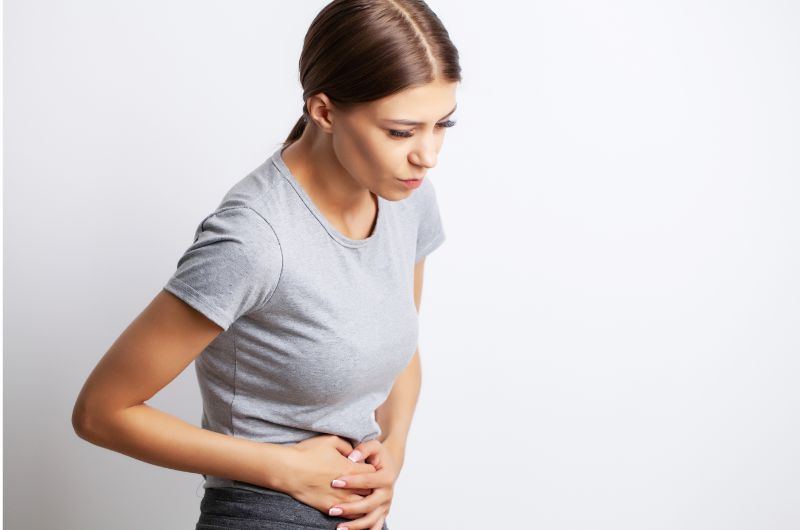Foods that are naturally or artificially red can color your poo with a reddish pigment. Strawberries are a common culprit, along with other varieties of red fruits such as raspberries, watermelon, tomatoes, and cherries. It’s only natural, especially when you haven’t digested the whole portion of the fruits you ate. But, sometimes, a red poop can be a symptom of a problem in your digestive tract. Internal bleeding could be happening, which usually gives you symptoms like vomiting blood, severe muscle pain and headaches, vision loss, and lightheadedness due to low blood pressure.
Of course, you’re used to having your poos in shades of brown. So, it’s understandable that you’ll feel very alarmed when they appear to have red flecks.
Before you panic and lose your mind, think about what you have eaten recently. Experts believe that diet can cause the changing shades of your stools.
What foods can make your poop red?
Seeing your bowel with red blood-like stuff on them is not always a sign of illness.
It could be due to the red fruit you ate at breakfast or the Kool-Aid you drank after snacking. Think of what red food you had in your meals, which could color your poo red.
Below are some of the common food items that will most probably cause you to have false bloodied stools:
- Fruits like strawberries, raspberries, watermelon, tomatoes, cherries
- Vegetables like beets, bell peppers, red kidney beans, etc.
- Foods with red food coloring like red licorice, Kool-Aid, red Mountain Dew, red cakes, red Jell-o or gelatin, and red popsicles or ice lollies
Remember that most of the food you eat will be digested and absorbed as nutrients by your body. The remaining undigested portion and other wastes will come out of your gut.
Is it bad to eat too many strawberries?

Eating strawberries can lower your risk of heart-related diseases, regulate your blood sugar levels, and stop the growth of cancer cells. That’s because strawberries contain a healthy amount of beneficial nutrients, vitamins, and minerals.
They have lesser amounts of fat and protein but are very high in:
- Water content – Will cover your daily water needs, make you feel full and reduce your chances of unhealthy snacking.
- Dietary fiber – Aids digestion, stabilizes your blood sugar levels and controls your food cravings which will help you lose weight.
Strawberries also contain relatively good amounts of:
- Vitamin C – Fights infection, keeps your skin glowing, and prevents age-related eye diseases.
- Vitamin B9 – Prevents heart diseases, growth of cancerous cells, and congenital disabilities during pregnancy.
- Potassium – Regulates blood pressure and reduces inflammation.
- Manganese – Improves bone health and formation, aids in metabolism, and supports other bodily processes such as vitamin absorption, cognitive functions, food digestion, etc.
Strawberries are also packed with antioxidants that improve your skin health, fight bacterial infection, and prevent abnormal growth of cells in your body.
However, eating too many strawberries can cause minimal to dangerous side effects. When you overeat anything, it’s expected that you’ll experience an upset stomach.
Because of the high fiber content of strawberries, you’ll most likely feel bloated, experience passing gas too often, and get diarrhea when you eat large amounts of them.
More often than not, you may also have a hard time passing your stools. It commonly occurs in people with sensitive gut or other gut problems and cannot break down a large quantity of fiber intake.
Other potential side effects of eating too many strawberries in one sitting include acid reflux and heartburn.
People with kidney problems can add strawberries to their meals or snacks following a low-potassium diet. But only moderately, about 2-3 servings per week (1/2 cup or 5 pieces per serving), as eating too many strawberries may spike the potassium levels in your blood, and that’ll cause more problems.
How long does it take to digest strawberries?
Well, that depends on several factors, including the fruit’s type and amount of fiber, your gut health, your gender, and other things.

If you have digestive problems, it may take longer to digest strawberries or any other fruit.
Strawberries have both insoluble and soluble fibers. About 60% of the fiber content of strawberries is insoluble, while the remaining 40% is soluble. That means strawberries could be fast to digest because of their higher amounts of insoluble fiber.
Soluble fiber is the type that dissolves easily in water and can slow down digestion but softens stools and improves your waste elimination.
On the other hand, insoluble fiber can increase your stool volume because it passes through your digestive tract intact, promoting regular bowel movement and preventing risks of constipation.
I haven’t eaten any red foods! Why is my poop reddish or pink?
Sometimes, problems in your digestive tract could be the culprit.
Conditions like the following would cause your stools to have bloodied pigments on them:
- Hemorrhoids
- Anal fissures
- Inflammation in your colon
- Abnormalities in the blood vessels in your gut result in bleeding
- Peptic ulcers
- Colon cancer or polyps
- Varicose veins or tears in your esophagus
- Inflammatory bowel diseases like Chron’s disease, ulcerative colitis, and/or indeterminate colitis
When you can’t think of any food that could’ve caused your stool to have a red hue, it’s time for you to visit your doctor and ask for a diagnostic test.
Often, when bloodied stools are caused by problems in your GI tract, you may develop other symptoms.
Another sign to look out for is when there’s blood in the tissue you’ve used to clean your bottom after passing out your stools.
What does blood in poop look like?
Blood on your stools may be hard to spot because it could just be some undigested part of the food you had earlier or the red food coloring in your drink during meals.
Bloodied poop can appear in different shades. It will depend on what’s causing the blood or the location of bleeding in your GI tract.
A light or bright red shade of coating on your stools or red flecks of colors mixed within it could indicate bleeding in your lower GI tract.
On the other hand, darker, blackish, and/or tarry stools could be a sign of bleeding in the upper part of your GI tract.
You shouldn’t ignore any signs of blood in your stools.
Home-kits are available to examine your wastes, but nothing’s for sure until you get a proper diagnostic test from your doctor.
When the reddish or pinkish hue on your stools is only caused by your diet, your poo should return to its normal shade within a day or two, and that’s usually brown.
If you experience vomiting blood or substances that look like coffee grounds, your bloodied stool is certainly not from the food or drink you had. There’s something wrong with your body, and you should seek medical attention immediately.
How to know if you have internal bleeding?
Internal bleeding is usually a sign of an injury or fracture, inflammation due to side effects of medications, a hereditary condition, and a symptom of mild to chronic diseases.
It can give you various symptoms which can happen out of the blue.
Sometimes, symptoms will only appear once you have already lost a good amount of blood.
There are also cases when small amounts of blood loss can give you severe symptoms and may even be fatal.
When you are suffering from internal bleeding, you may experience the following symptoms:
- Lightheadedness, severe headache, and pain
- Tingling of your hands and/or feet
- Shortness of breath and slurred speech
- Vision becomes blurry or completely loss
- General weakness
- Confusion, memory loss, and disorientation
- Severe, shooting pain in the stomach causing nausea and vomiting
- Bruising
- Rectal bleeding
- Blood in stool or urine
- Bruising on the site of bleeding
Below are severe symptoms of internal bleeding:
- Palpitations and seizures
- Cold skin but sweaty to touch
- Little to no urination
- Vomiting blood or tarry substances
- Loss of consciousness
- Bleeding on your eyes, ears, or nose
- Organ failure
- Comatose
Conclusion
Strawberries are a common fruit that could make your poop turn to a reddish or pinkish hue.
Other food items like beets, bell peppers, red kidney beans, and snacks with red food coloring can also give you false bloodied stools.
It’ll be hard to know if the blood in your poo is real unless you visit your doctor’s clinic and get a diagnostic test. But, if you did have any red-colored food earlier in your meals or snacks, you shouldn’t panic.
Observe if your poo changes back its color to normal within a day, and if you don’t feel any symptoms like vomiting, lightheadedness, severe pain, bruising, or anything at all, then you should be fine.
Otherwise, the blood in your stool is a symptom of internal bleeding.


